RARE African-American Mortar & Pestle for Magic Mushrooms Slave Plantation, SC

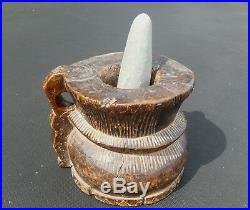
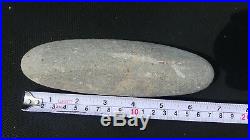

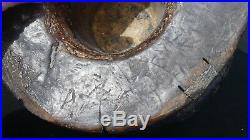
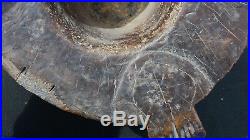
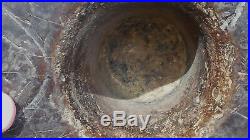

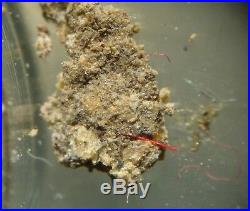
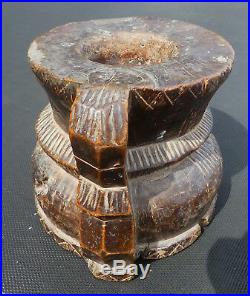

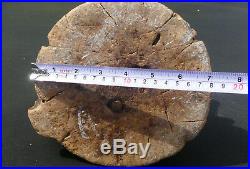

Antiques, Artifacts & Fine Collectibles. Primitive African-American/Native American Mortar & Pestle. Museum Quality, 200-250-Year-Old Wooden Mortar that Prepared. Hallucinogenic Psilocybe Magic Mushrooms on Southern Plantation. Pictographic Incantation Carved into the Mortars Rim! Boone Hall Plantation: Charleston, South Carolina. 18th or Early 19th Century.
Wooden Mortar with Pictographic Incantation and Stone Pestle. Mount Pleasant, Charleston County, South Carolina, U. Near Boone Hall Plantation & Gardens. Hand carved wood & shaped stone pestle. 3.8 (96 mm) deep x 3.4 (87 mm) in diameter.
Authentic and original use from many years of use as a mortar. There are dings, some nail and material old repairs and more modern restorations on the rim, cracks and abrasion scratches in this wooden mortar that are consistent with it age and use from about 200 to 250-years-ago. There is still residue that remains inside the mortar at the base of the hole that has been microscopically identified (see photos # 8-9) as a type of hallucinogenic mushroom called Psilocybe. I Guarantee it to be original and authentic! Please see photos taken outdoors for details.This fascinating carved, wood mortar that is in the shape of a huge mushroom came from near an old, slave plantation southwest of Charleston, South Carolina. The antebellum era plantation, called Boone Hall Plantation, is located in. And listed on the National Register of Historic Places. This large mortar is EXTREMELY RARE in both its style and purpose and it is the only one of its type known to exist!
It is in museum quality condition! Samples taken from inside this mortar suggest it was likely used by a Native American shaman/priest or an African-American slave on a Southern plantation to prepare hallucinogenic mushrooms that would aid in spiritual quests of those who used the drug. Each shaman was believed to carry within him a number of animal spiritsmost commonly in the form of lizards and snakesthat directed and guided his visions and judgements. Decisions were make on the basis of advice supposedly received from such supernatural animal helpers. The enhanced visions caused by the hallucinogenic mushrooms helped the shaman to contact the spirits for intervention into human affairs. The wooden mortar, shaped like a giant mushroom, is very heavy and weighs almost six pounds. It is made from a single piece of wood that has been hand-carved and then artfully decorated with many vertical incisions across the base sides and on the small handle. The style of carving suggests it was made by an Black slave from Africa. But perhaps most intriguing, are the small, pictographic symbols (see macro photos 4-6) that have been carved into the flat edge of the rim that surrounds the center hole. Perhaps an incantation the shaman would make while preparing the hallucinogenic mushrooms and honey mixture or perhaps it is the owners name in pictographs. It does not appear to use the English alphabet, and some pictographs on the side appear to be Native American teepees and other symbols. The associated 6.75 long stone pestle is clearly a native American stone tool, probably picked up during field clearance and perfectly suited for crushing/grinding items with in the mortar bowl. It is included in this sale!This mortar and pestle came from a collector's private outbuilding that was located about a mile from Boone Plantation in South Carolina. The previous owner of this mortar was curious as to what was mixed into the base of this artifact, hence the microscopic views--which are clear evidence of mushroom use.
Perhaps more interestingly, use via a particular type of fungi that were never utilized for flavor, only for the effects of their hallucinogenic chemistry that had been utilized by Native Americans for millennia. Curiously, magnification of the residue within the bowl showed evidence of tiny, clear quartz pieces (sand residue) a binder (such as honey) and mushroom myceliumthe vegetative part of a fungus bacterial colony, almost looking like branching threadsand some of these branches were red (see microscopic photos 8-9). So, either the people using this mortar, likely slaves as this was found on the old Boone Plantation, were interested in preparing a dish that included mushrooms or they were grinding these particular mushrooms for another reason. Red mycelia (see photo # 9) either suggests some type of bacterial contamination or they are the product of what is popularly known as psilocybe or magic mushroomsthose red-capped things that can induce a euphoric state of mind that is dreamy, relaxing and then very intensesome say similar to the mental effects of LSD.
Some people today who have imbibed have reported life-changing, vivid thoughts and experiences after taking the drug; while many Native Americans and Meso-Americans in the 21. Century still legally use these mushrooms for ritual purposes. My suspicion is that such a mix of mushroom with honey was probably an idea picked up from local Native American shamans, perhaps sharing their information with plantation slaves. This mortar was probably used by shaman/priests to prepare hallucinogenic compounds that were thought to enable them to better communicate with the many spirits that they encountered in their trances.
Native Americans in South Carolina. At least 29 distinct tribes of Indians once lived within the land we now call South Carolina. Many of the tribes that once lived in South Carolina are now extinct or were forcibly relocated to Oklahoma.
This means that there are either no surviving members or that they no longer organize themselves as a tribe. A few tribes, however, still exist and are active today. This means that descendants of the original tribe organize themselves, either socially or politically, as a group. The Catawba, Pee Dee, Chicora, Edisto, Santee, Yamassee, and Chicora-Waccamaw tribes are all still present in South Carolina, as are many descendants of the Cherokee. When the Europeans arrived in East Coast during the 17.
Centuries, they encountered the last remaining vestiges of the once flourishing Mississippian Culture. These people, perhaps by association through trade with the Aztec Empire of Meso-America, believed that their leaders claimed direct descent from an omnipotent Great Sun God. Shaman/priest would awake tribal chiefs who were called werowances every morning and sample every morsel of food he ate to ensure that it would suit his tastes and would be acceptable. At his death, the entire tribe would go into mourning and the closest family members would beg to be strangled in order to accompany him to the other world. Shaman/priests and the tribal Chiefs functioned equally as leaders had both secular and religious power. Southeastern shaman had to be born into families whose lineage was unquestioned. They had to be taught how to speak a shamanic language, as they only could communicate with the Sun God, animals, and other spirits only in an ancient common language that was no longer understood by ordinary people. The mushroom, as it comes from the Earth, may represent the mythical conflict between the deities of the Lower World and the honey produced by bees would represent the Upper World. Effect of the mushrooms had a powerful narcotic effect that was useful as an aid to attaining deep, trance like states through which the Spirits could be reached. Boone Hall Plantation: {Ref: Wikipedia}. The antebellum era plantation, called Boone Hall Plantation, is located in Mount Pleasant, Charleston County, South Carolina, U. It has undergone many changes over 337 years and is now open to the public. John Thomas Boone, an Indian Trader, received the land known as Boone Hall Plantation as a grant from the Eight Lord Proprietors in 1681. The Boones began growing indigo, and thus began a long history of providing Boone Hall crops for the South Carolina low country and the world. This historical plantation includes a large Colonial Revival plantation house (completed in 1936) that replaced the lost original house on the site, a number of slave cabins or cottages which were occupied by sharecroppers well into the 20.Century, several flower gardens, and the historic "Avenue of Oaks" an expanse of over a kilometer along the up to the house with southern live oaks on either side, that were originally planted in 1743. Boone Hall is one of America's oldest working plantations, continually growing crops for over 337 years. Boone Hall was founded in 1681 and its history as well as photos showing a glimpse of the current buildings and gardens that compose the 738 acres that make up the plantation today can be found on its web site. The brothers built many houses and public spaces in downtown Charleston using the brick from their plantations, of which by 1850, Boone Hall was producing 4,000,000 bricks per year using 85 slaves. The Horlbeck family improved the plantation by completing the Avenue of Oaks that lead up to the plantation house in 1843.
The Horlbecks also planted pecan trees on the plantation, so that by end of the century, Boone Hall was one of the leading producers of pecans in the United States. Native plants and fungi across the United States contain naturally-occurring hallucinogens. Many of these species have histories in the shamanistic rituals of Native Americans and Meso-Americans for thousands of years and several are still used as recreational drugs today. Magic mushrooms are commonly dried and then brewed as teas or eaten. Typically, one to two grams of the mushrooms is taken to provide the user with an LSD-like trip.
The principal hallucinogens in the psilocybe species of mushroom are psilocybin and psilocin. While they are non-lethal, they are similar in appearance to several other forms of poisonous mushrooms.
Not only do these varieties induce hallucinations, they also can lead to seizures or comas if ingested. Ethnomycology is the study of how people have used fungi as food, tinder, medicine, and spiritual tool and how this use has influenced them. Many cultures of the world consider mushrooms to be sacred curers of sickness and givers of information. Youve probably heard of the Amanita muscaria , that handsome red mushroom with white spots, or maybe even of the Psilocybe mushrooms of Mexico, so sacred they were called Gods Flesh.An intriguing but less discussed topic is the use of fungi by Native Americans of North America. A psilocybin mushroom, also known as a. Is one of a polyphyletic group of mushrooms that contain any of various psychedelic compounds including psilocybin, psilocin, and baeocystin.
Common colloquial terms for psilocybin mushrooms include magic mushrooms, shrooms, and mush. They are used mainly as an entheogen and recreational drug whose effects can include euphoria, altered thinking processes, closed and open-eye visuals, synesthesia, an altered sense of time, and spiritual experiences. Biological genera containing psilocybin mushrooms include Copelandia, Gymnopilus, Inocybe, Mycena, Panaeolus, Pholiotina, Pluteus, and Psilocybe. Over 100 species are classified in the genus Psilocybe. Psilocybin mushrooms may have been used since prehistoric times.
They are possibly depicted in Stone Age rock art in Europe and Africa and have a history of use in pre-Columbian Mesoamerica. Some cultures have used these mushrooms in their religious rites and ceremonies. The concentration of active psilocybin mushroom compounds varies not only from species to species, but also from mushroom to mushroom inside a given species, subspecies or variety. The same holds true even for different parts of the same mushroom.
In the species Psilocybe samuiensis , the dried cap of the mushroom contains the most psilocybin at about 0.23%0.90%. The mycelium contains about 0.24%0.32%.Archaeological evidence suggests that psilocybin-containing mushrooms have been used by humans since prehistoric times. It has been argued that prehistoric rock art near Villar del Humo, Spain, offers evidence that Psilocybe hispanica was used in religious rituals 6,000 years ago, and that art at the Tassili caves in southern Algeria from 7,000 to 9,000 years ago may show the species Psilocybe mairei. Hallucinogenic species of the Psilocybe genus have a history of use among the native peoples of Mesoamerica for religious communion, divination, and healing, from pre-Columbian times to the present day.
Mushroom stones and motifs have been found in Guatemala. A statuette dating from ca. And depicting a mushroom strongly resembling Psilocybe mexicana was found in a west Mexican shaft and chamber tomb in the state of Colima.
A Psilocybe species was known to the Aztecs as tenancatl literally "divine mushroom" - agglutinative form of tetl (god, sacred) and nancatl (mushroom) in Náhuatl and were reportedly served at the coronation of the Aztec ruler Moctezuma II in 1502. Aztecs and Mazatecs referred to psilocybin mushrooms as genius mushrooms, divinatory mushrooms, and wondrous mushrooms, when translated into English. Bernardino de Sahagún reported ritualistic use of teonanácatl by the Aztecs, when he traveled to Central America after the expedition of Hernán Cortés. Each object I sell is professionally researched and compared with similar objects in the collections of the finest museums in the world. When in doubt, I have worked with dozens of subject matter experts to determine the condition and authenticity of numerous antiquities and antiques. All sales are Final, unless I have seriously misrepresented this item. Please look at the photos carefully as they are part of the description. Member of the Authentic Artifact Collectors Association (AACA) & the Archaeological Institute of America (AIA). The item "RARE African-American Mortar & Pestle for Magic Mushrooms Slave Plantation, SC" is in sale since Wednesday, April 17, 2019. This item is in the category "Collectibles\Cultures & Ethnicities\Native American\ US\1600-1799\Other Nat.The seller is "houghton-usa" and is located in Sequim, Washington. This item can be shipped to United States, Canada.
- Country/Region of Manufacture: United States
- Artisan: Unknown Cherokee or Slave
- Provenance: Ownership History Available
- Origin: South Carolina
- Tribal Affiliation: Cherokee
